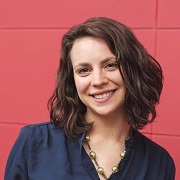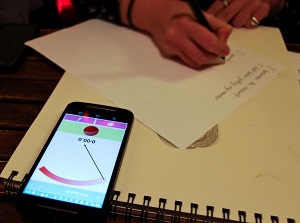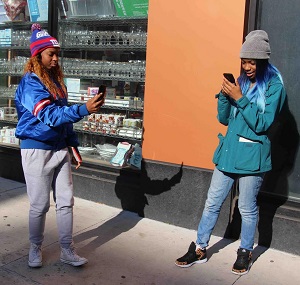 Special to The Philanthropy Journal
Special to The Philanthropy Journal
By Kathryn Weenig
“I am really happy I was able to speak,” says ‘Y,’ a participant in Footage Foundation’s Girl-talk-Girl program in St. Petersburg, Russia. Using a mobile phone application, which she helped redesign, Y constructed and shared a personal story of gender-based violence and engaged in global dialogue. With girls and young women like Y, Footage creates technology, measurable interventions, and leadership opportunities that amplify their voices around social issues deeply affecting their lives.
 Footage believes positive, lasting transformation occurs when young people contribute their experiences, strengths, needs, hopes, and perspectives. By facilitating unique narrative labs and applying the science of compassion, Footage’s international, interdisciplinary team dedicates themselves to ensuring the impact and sustainability of its mission to raise voices to elevate lives.
Footage believes positive, lasting transformation occurs when young people contribute their experiences, strengths, needs, hopes, and perspectives. By facilitating unique narrative labs and applying the science of compassion, Footage’s international, interdisciplinary team dedicates themselves to ensuring the impact and sustainability of its mission to raise voices to elevate lives.
Five women PhD candidates at Cambridge University founded the organization in 2008, with resolve to better the lives of marginalized young people, particularly young women, through social science and media arts. They envisioned initiatives that would access youth voice and form grassroots movements with compassion and empathy at their core. To date, the public has voted Footage a top 10 nonprofit in New York City for Givkwik’s Giv.NYC event, the US State Department has backed their innovative methods, and the National Academies of Sciences, Engineering, and Medicine has requested to learn the role of technology and youth voice in global violence prevention. Research and program evaluation has revealed to the organization how storytelling skills impact youth well-being on individual, communal, and global levels.
 Footage programs start and end with elevating participants as agents of change. ‘R,’ another young woman from St. Petersburg says, “In the beginning, it was hard to understand how to tell my story. But when I started, I became inspired by my work.” Through digital narrative, she told of her uncle physically abusing her aunt in public and challenged social acceptance of family violence. R was recruited to tell her story and guided through the process by a former Girl-talk-Girl participant via a peer-to-peer training model Footage uses to scale its programs.
Footage programs start and end with elevating participants as agents of change. ‘R,’ another young woman from St. Petersburg says, “In the beginning, it was hard to understand how to tell my story. But when I started, I became inspired by my work.” Through digital narrative, she told of her uncle physically abusing her aunt in public and challenged social acceptance of family violence. R was recruited to tell her story and guided through the process by a former Girl-talk-Girl participant via a peer-to-peer training model Footage uses to scale its programs.
Through the original Girl-talk-Girl initiative, young women in St. Petersburg and New York City participated in narrative labs, learned about gender-based violence, shared experiences on an international platform, and garnered insights for open-source educational resources. They used human-centered design to rethink a mobile storytelling application, adapting it to suit their needs and the sensitivity of discussing violence (Eg., a voice changing function to protect each other’s identities).
For young women at-risk to violence, Girl-talk-Girl is more than a program: it’s a platform, a tool, an experience they use to ignite social change. They not only bravely tell their stories, but also design technology so others may tell theirs. Whether participants undergo training to become leaders or solely share their stories, they envision their work with Footage as a force for good. “Maybe after watching my story, some people will think about the problem of domestic violence, will change something in themselves, or will try to change something in their environment,” says R.
 Storytelling is not simply creating content; it is a transformative process. When supported by research and best practice, its ability to catalyze and sustain positive change deepens. Footage measures this impact using targets it identifies as Drivers of Change: compassion and empathy; education; advocacy; community and connection; and awareness. These drivers advance the United Nations Sustainable Development Goals (SDGs), aligning Footage’s programs with the vision and practices of the global community. For example, education is vital in achieving Footage’s mission as it is a robust indicator of health, quality jobs, and just societies. The organization approaches education in its broadest sense, from preparation for employment to the cultural and expansive learning that occurs when young people from different parts of the world share their experiences.
Storytelling is not simply creating content; it is a transformative process. When supported by research and best practice, its ability to catalyze and sustain positive change deepens. Footage measures this impact using targets it identifies as Drivers of Change: compassion and empathy; education; advocacy; community and connection; and awareness. These drivers advance the United Nations Sustainable Development Goals (SDGs), aligning Footage’s programs with the vision and practices of the global community. For example, education is vital in achieving Footage’s mission as it is a robust indicator of health, quality jobs, and just societies. The organization approaches education in its broadest sense, from preparation for employment to the cultural and expansive learning that occurs when young people from different parts of the world share their experiences.
‘J,’ a Girl-talk-Girl participant in New York City says, “I feel like I contributed something, but I feel like I gained more…I feel like mine is just a drop in the bucket compared to what I’ve learned and what I’ve seen, and what I’ll take home, and what I can now view and understand from not only girls here, but girls abroad.” In Girl-talk-Girl, participants build skills in communication, technology, and ideation, generating creativity and leadership, as well as achieving the United Nations’ goal for increased use of Information and Communication Technologies (ICTs) by women and girls. Not only do Footage’s programs support youth in obtaining quality employment and wellbeing, but they equip youth with tools to thrive as innovators.
 Moving forward, Footage views the current refugee crisis and dialogue around immigration as a critical time for gender-specific voice programming. With human displacement at the highest ever recorded and the vulnerability of affected girls and women sharply increasing, the International Rescue Committee has identified listening to displaced girls and women as the primary step in providing them adequate aid. Thus, Footage expanded Girl-talk-Girl and started Her{connect}Her in 2016. The program uses narrative to engage displaced young women worldwide in community needs assessment and cultivates resilience, empowerment, and empathy. It is set to offer policy makers and NGOs insights into effective services and facilitate the global community in recognizing its shared humanity. By telling one’s story and hearing another’s story, discovering commonalities that surpass political and cultural boundaries, Footage hopes Her{connect}Her participants and those who hear their stories can exercise compassion. Current research correlates compassion toward others and one’s self with positive health and social outcomes.
Moving forward, Footage views the current refugee crisis and dialogue around immigration as a critical time for gender-specific voice programming. With human displacement at the highest ever recorded and the vulnerability of affected girls and women sharply increasing, the International Rescue Committee has identified listening to displaced girls and women as the primary step in providing them adequate aid. Thus, Footage expanded Girl-talk-Girl and started Her{connect}Her in 2016. The program uses narrative to engage displaced young women worldwide in community needs assessment and cultivates resilience, empowerment, and empathy. It is set to offer policy makers and NGOs insights into effective services and facilitate the global community in recognizing its shared humanity. By telling one’s story and hearing another’s story, discovering commonalities that surpass political and cultural boundaries, Footage hopes Her{connect}Her participants and those who hear their stories can exercise compassion. Current research correlates compassion toward others and one’s self with positive health and social outcomes.
“We know deep down that there is a really human level that we all have and that we all experience, but just to physically see it and be reminded of it has been a really awesome experience,” says ‘Z,’ a Girl-talk-Girl participant in New York City. Young people carry experiences, perspectives, and potential that when harnessed, mobilize one of society’s largest untapped resources. Footage believes they not only serve as leaders and change agents of the future, but of the present.
Kathryn Weenig is Impact Manager at Footage Foundation and believes increasing access to storytelling is a means of social justice. With a B.A. in English/Creative Writing, Studio Art, and European Studies, she has created empowerment programming for diverse youth, served as a youth mental health advocate, educator, and spokesperson, contributed to research projects regarding child wellbeing and education, and was once an award-winning student journalist.




